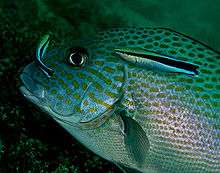List of symbiotic relationships
Symbiosis can vary between mutualism, commensalism, and parasitism, though these grade into each other, and it is often difficult to tell which is involved in a given relationship. In mutualism, both organisms benefit. In commensalism, one benefits and the other is unaffected; in parasitism, one benefits and the other is harmed.
Some of these relationships are so close that we speak of the composite of two species as one unit; for example, we speak of the composite of algae and fungi as lichens.
Mutualism
A type of symbiotic interaction in which both organisms benefit from the relationship in some way.
Commensalism
An interaction in which one organism benefits from the relationship without causing benefit or harm to the other organism.
Parasitism
A type of symbiotic interaction in which one organism benefits and the other is harmed.
Cleaning symbiosis

Many species are involved in cleaning symbiosis, though claimed symbioses grade into commensalism, scavenging and parasitism. A clearly symbiotic example is the cleaner wrasse Labroides, a small fish conspicuously shaped and marked, being longitudinally striped with blue. It eats only ectoparasites at "cleaning stations" from the bodies of larger fish such as puffers, sweetlips and groupers.[1][2]
Endosymbiosis
| Symbiosis by luci | Endosymbiont | Role of endosymbiont | Role of host |
|---|---|---|---|
| Euprymna scolopes (Mollusca) | Vibrio fischeri | Counter-illumination via bioluminescence[3] | Reproduction |
| Legumes | Rhizobia | Fixed nitrogen | Photosynthesis (principally as the dicarboxylic acids malate and succinate) |
| Actinorhizal plants | Frankia bacteria | Fixed nitrogen | Photosynthesis (principally as the dicarboxylic acids malate and succinate) |
| Anglerfish | Bioluminescent bacteria | Bioluminescent lure for prey capture | Protection |
| Vascular plants | mycorrhizae | Sequestering of phosphate ions from soil, disease protection | Photosynthates |
| Parasitoid wasps | Polydnavirus | Immune suppression of parasite host | Propagation of the virus |
| Poaceae | Endophytic fungi | Disease prevention, Drought tolerance[4] | Photosynthates |
Autotrophic endosymbioses
| Host | Endosymbiont | Role of endosymbiont | Role of host |
|---|---|---|---|
| Coral (Cnidaria), other invertebrates | Zoochlorellae (green algae), zooxanthellae ("non-green" algae, typically dinoflagellates, cryptomonads, chrysomonads or diatoms) | Photosynthates | Protection, inorganic nutrients |
| Foraminifera, ciliates (protists) | Variety of algae | Photosynthates | Locomotion, protection, inorganic nutrients |
| Sponges (Porifera) | Variety of algae (Often green-algae) | Photosynthates | Protection, inorganic nutrients |
| Hydra viridis (Cnidaria) | Chlorella | Photosynthates[5] | Inorganic nutrients |
| Elysia viridis (Mollusca) | Codium fragile | Photosynthates[6] | Locomotion, protection, inorganic nutrients |
| Convoluta roscoffensis (Platyhelminthes, traditionally) | Tetraselmis convolutae | Locomotion, protection, inorganic nutrients | |
| Pompeii worm, Alvinella pompejana (Annelida) | Thermophilic chemoautotrophic bacteria | Insulation, chemosynthates | Locomotion, inorganic nutrients |
| Mole salamanders | Oophila | Oxygen (from photosynthesis) | Carbon dioxide (from respiration) |
| Riftia pachyptila (Annelida) | Bacteria | ||
| Solemya velum (Mollusca) | Sulfur-oxidizing chemoautotrophic bacteria[7] | ||
| Orphium frutescens | Xylocopa violacea (Female Carpenter Bee) | nutrients for larvae | Locomotion of Reproduction |
Digestive endosymbioses
- Humans and intestinal bacteria
- Ruminants such as cows and their intestinal bacteria and protists
- Termites and their intestinal bacteria and protists
- Aphids and Buchnera bacteria[8]
See also
References
- ↑ Helfman, G; Collette, B.; Facey, D. (1997). The Diversity of Fishes. Blackwell Publishing. p. 380. ISBN 0-86542-256-7.
- ↑ Fenner, Robert M. (2001). The Conscientious Marine Aquarist. TFH. pp. 282–283. ISBN 1-890087-02-5.
- ↑ Young, R.E. & C.F. Roper 1976. Bioluminescent countershading in midwater animals: evidence from living squid. Science 191(4231): 1046–1048.1251214
- ↑ "Archived copy". Archived from the original on 2006-03-12. Retrieved 2009-06-14.
- ↑ Matthias Habetha et al. The Hydra viridis / Chlorella symbiosis.
- ↑ R.K. Trench, J.E. Boyle and D.C. Smith (1973). "The Association between Chloroplasts of Codium fragile and the Mollusc Elysia viridis. I. Characteristics of isolated Codium chloroplasts". Proceedings of the Royal Society of London. Series B, Biological Sciences 184 (1074): 51–61. doi:10.1098/rspb.1973.0030.
- ↑ http://www.springerlink.com/content/e24615311h534725/fulltext.pdf
- ↑ Douglas, A E (1998). "Nutritional interactions in insect-microbial symbioses: Aphids and their symbiotic bacteria Buchnera". Annual Review of Entomology. 43: 17–38. ISSN 0066-4170. PMID 15012383. doi:10.1146/annurev.ento.43.1.17.